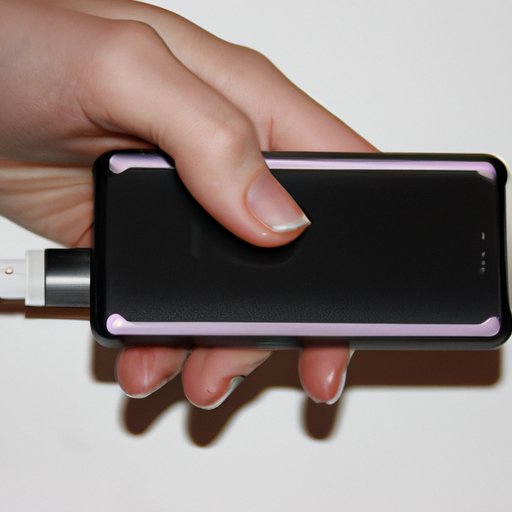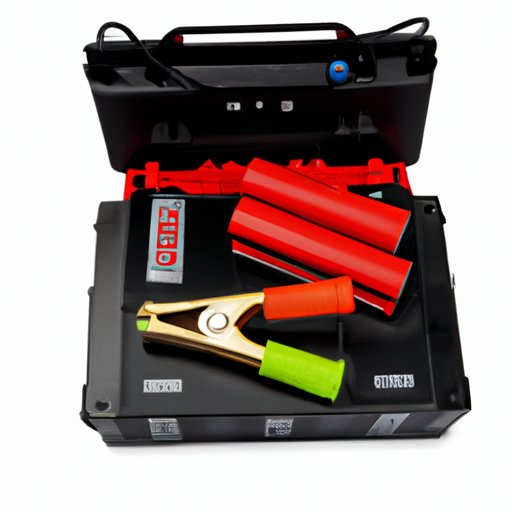Introduction
A dead car battery can be a major inconvenience, especially if you’re running late for an appointment or stuck at home during bad weather. Fortunately, there are several methods you can try to get your car going again without having to call a tow truck. In this article, we will explore six different ways to start your car with a dead battery.
Overview of the Problem
When the battery in your car dies, it is usually because it is not receiving enough charge from the alternator. This can be caused by a defective alternator, a loose connection between the battery and alternator, or an old or weak battery that has reached the end of its life span. If your car has a manual transmission, you may also be able to push start it.
Reasons Why Batteries Die
Car batteries typically last between three and five years, depending on how often they are used and their quality. A few common reasons why batteries die include:
- Leaving headlights or other electronics on for too long
- Frequently short trips that don’t allow the battery to fully recharge
- Extreme hot or cold temperatures
- Corrosion on the battery terminals
- Old age
Jumpstarting the Car
Jumpstarting a car is one of the most common methods of getting a car going when the battery is dead. It involves connecting the dead car’s battery to another car’s battery with jumper cables in order to provide a temporary boost of power.
What is Jumpstarting?
Jumpstarting a car means connecting the battery of one car to the battery of another car with jumper cables. The working battery provides a temporary boost of electricity to the dead battery, allowing the car to start.
How to Jumpstart a Car
Jumping a car is simple, but it’s important to follow the steps carefully and make sure all connections are secure. Here’s how to do it:
- Park the two cars close together so the jumper cables can reach both batteries.
- Turn off both cars and pop the hoods.
- Attach one end of the red (positive) cable to the positive terminal of the dead battery.
- Attach the other end of the red cable to the positive terminal of the working battery.
- Attach one end of the black (negative) cable to the negative terminal of the working battery.
- Attach the other end of the black cable to a metal part of the car with the dead battery (not the battery itself).
- Start the working car and let it run for a few minutes.
- Try starting the car with the dead battery.
- Once the car with the dead battery is running, remove the cables in the reverse order.
Safety Precautions
Before attempting to jumpstart a car, it’s important to take certain safety precautions. Make sure the battery terminals are clean and free of corrosion before connecting the cables. Wear protective gloves and eyewear to protect yourself from sparks. Avoid touching the metal parts of the cables while the car is running. If the car does not start after a few attempts, do not continue trying – it could damage the battery or other electrical components.

Using a Portable Battery Charger
If you don’t have access to another car, you can use a portable battery charger to jumpstart your car. Portable battery chargers are small, battery-powered devices that are designed to jumpstart a car in an emergency.
What is a Portable Battery Charger?
A portable battery charger is a device that uses a built-in battery to provide a temporary boost of power to a dead car battery. They are small and easy to carry, making them ideal for emergency situations.
How to Use a Portable Battery Charger
Using a portable battery charger is relatively simple. Here’s how to do it:
- Make sure the car is turned off and the hood is open.
- Connect the charger to the car battery using the included clamps.
- Turn on the charger and wait for the battery to charge.
- Start the car and let it run for a few minutes.
- Once the car is running, turn off the charger and disconnect it from the car.
Safety Precautions
When using a portable battery charger, always read the instructions carefully and follow them precisely. Do not attempt to jumpstart a car if you are unfamiliar with the process – it could cause serious damage to the car or injury to yourself. Make sure the charger is disconnected from the car before turning it on or off.
Replacing the Battery
If your battery is more than three years old and has been dying frequently, it may be time to replace it. Replacing a car battery is a fairly straightforward process, but it’s important to take certain safety precautions.
When to Replace a Battery
Car batteries typically last between three and five years, depending on how often they are used and their quality. If your battery is more than three years old and has been dying frequently, it may be time to replace it. You should also consider replacing the battery if it is leaking or shows signs of corrosion.
Steps for Replacing a Battery
Replacing a car battery is a straightforward process that anyone with basic mechanical skills can do. Here’s how to do it:
- Open the hood and locate the battery.
- Disconnect the negative cable first, then the positive cable.
- Remove the bolts holding the battery in place.
- Carefully lift the old battery out of the car.
- Clean the battery tray and terminals with baking soda and a wire brush.
- Place the new battery in the tray and reattach the bolts.
- Reconnect the positive cable first, then the negative cable.
- Close the hood and start the car.
Safety Precautions
When replacing a car battery, always wear protective gloves and eyewear to protect yourself from sparks. Make sure the battery terminals are clean and free of corrosion before reconnecting the cables. Do not attempt to replace a car battery if you are unfamiliar with the process – it could cause serious damage to the car or injury to yourself.
Push Start the Car
If your car has a manual transmission, you may be able to push start it in order to get it going. Push starting a car requires a few people to help push the car and someone to sit in the driver’s seat and steer.
What is Push Starting?
Push starting a car is a method of getting the car going without the use of a battery. It involves pushing the car until it reaches a certain speed and then engaging the clutch to start the engine. This method only works on cars with manual transmissions – it will not work on cars with automatic transmissions.
How to Push Start a Car
Push starting a car is relatively simple, but it’s important to follow the steps carefully. Here’s how to do it:
- Put the car in second gear and make sure the parking brake is engaged.
- Get a few people to help push the car until it reaches about 5 miles per hour.
- Have the person in the driver’s seat press the clutch and start the engine.
- Once the car is running, release the clutch and drive away.
Safety Precautions
Before attempting to push start a car, make sure the parking brake is engaged and the car is in second gear. If the car does not start after a few attempts, do not continue trying – it could damage the transmission or other components. Only attempt to push start a car if you are familiar with the process.
Installing a Battery Booster Pack
If you don’t have access to another car, a battery booster pack can be a lifesaver. Battery booster packs are small, battery-powered devices that can provide enough power to start a car in an emergency.
What is a Battery Booster Pack?
A battery booster pack is a small, battery-powered device that can provide enough power to start a car in an emergency. They are relatively inexpensive and easy to use, making them ideal for roadside emergencies.
How to Install a Battery Booster Pack
Installing a battery booster pack is relatively simple. Here’s how to do it:
- Make sure the car is turned off and the hood is open.
- Connect the booster pack to the car battery using the included clamps.
- Turn on the booster pack and wait for the battery to charge.
- Start the car and let it run for a few minutes.
- Once the car is running, turn off the booster pack and disconnect it from the car.
Safety Precautions
When using a battery booster pack, always read the instructions carefully and follow them precisely. Do not attempt to jumpstart a car if you are unfamiliar with the process – it could cause serious damage to the car or injury to yourself. Make sure the pack is disconnected from the car before turning it on or off.
Conclusion
A dead car battery can be a major inconvenience, but it doesn’t have to be a disaster. With the right tools and knowledge, you can get your car going again in no time. There are several methods you can try to start your car with a dead battery, including jumpstarting, using a portable battery charger, replacing the battery, push starting, and installing a battery booster pack. Always take safety precautions when attempting any of these methods and make sure you are familiar with the process before attempting it.
(Note: Is this article not meeting your expectations? Do you have knowledge or insights to share? Unlock new opportunities and expand your reach by joining our authors team. Click Registration to join us and share your expertise with our readers.)
